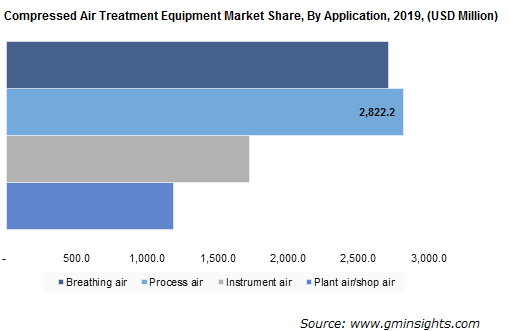U.S. Compressed Air Treatment Equipment Market Size, by Product, 2013 – 2024 (USD Million) U.S. Compressed Air Treatment Equipment Market Size, by Product, 2013 – 2024 (USD Million)
Publisher : Fractovia | Published Date : 2016-06-16Request Sample
Boasting a widespread end-use landscape encompassing food and beverage, chemical, and electronics sectors, compressed air treatment equipment market is expected to carve a lucrative roadmap in the years ahead. In today’s automated production facilities, the deployment of compressed air supply has become pivotal, a factor that can predominantly be credited for the upscaling of compressed air treatment equipment industry demand. Popularly known as the 4th utility, statistics depict that almost 90% of food companies incorporate compressed air in their operations in some way or the other. In this regard, it should be noted that untreated compressed air contains potentially harmful contaminants which if not processed or reduced to acceptable levels can prove to be health-hazardous for human. In a bid to address the escalating requirement, various innovative treatment techniques are continuously being implemented, which by extension is fueling compressed air treatment equipment market share.
U.S. Compressed Air Treatment Equipment Market Size, by Product, 2013 – 2024 (USD Million)

Speaking along similar lines, a strict regulatory framework related to food safety and hygiene maintenance has much to contribute in the compressed air treatment equipment industry outlook. Despite the fact that a larger fraction of the manufacturing processes is powered by compressed air, most of these hygiene regulations and standardizations are often overlooked in compressed air treatment due to lack of proper knowhow. However, with increasing number of food safety regulations having already been implemented across some of the major economies, the situation is soon to improve in the coming years. Some of the worldwide standards for food grade compressed air that have a perpetual impact on compressed air treatment equipment market outlook is listed below:
- The European Parliament and Council under regulation EC 852/2004 deals with certain standards on food hygiene that needs to be complied with.
- Generally, hygiene legislations require food manufacturers to initiate written FSMS (food safety management systems) based on HACCP principles (Hazard Analysis Critical Control Point). Since compressed air supply is closely linked to food industry, the aforementioned fact is a vital pointer that should be taken into consideration by compressed air treatment equipment industry players.
- In this regard, many companies are also adopting ISO standard ISO22000:2005 to fully endorse the principles of HACCP system. The ISO standard further claims that hazard analysis is the key to effective food safety management. This is sure to reflect in compressed air treatment equipment market share from food and beverage sector, which is expected to witness a y-o-y growth of 6.5% over 2017-2024
Claimed by experts as one of the most rapidly growing economies across the world, Asia Pacific witnesses a strong command in the global compressed air treatment equipment industry, primarily due to the rapid industrial expansion across the region. Taking into account the strong pipeline of industrial projects spanning across countries like China, Indonesia, Japan, the demand for compressed air treatment equipment market is sure to escalate in the coming years. Over 75% of all kinds of industrial applications require compressed air in their operation cycle. As per estimates, with China at the forefront, APAC is slated to cover almost 60% of the global infrastructural spending by the 2025. Based on these statistics, it can be aptly grounded that Asia Pacific would prove to be one of the most ruminative growth avenues for compressed air treatment equipment market. Global Market Insights. Inc., estimates the regional industry to exceed a valuation of USD 10 billion by 2024.
Speaking of competitive profiling, Atlas Copco continues to witness a strong foothold in the global compressed air treatment equipment industry space, procuring almost one-tenth of the overall share. The Swedish giant, it has been observed lately, is leaning toward strategic collaborations to expand its regional expansion and product reach. There has been a plethora of acquisitions undertaken by the Swedish conglomerate over the recent years. The very recent acquisition of Glauber Equipment Corporation’s compressor business, as claimed by experts, has been one of the most fruitful deals for the company in terms of profitability and ROI. Reportedly, through this acquisition, Atlas Copco got a direct access to Glauber Equipment’s extensive consumer base in compressed air treatment equipment market. Some of the other leading names partaking in the competitive hierarchy of compressed air treatment equipment industry include Gardner Denver, Ingersoll-Rand, Kaeser Kompressoren, Van Air, Parker Hannifin, and Donaldson Company.
Endorsed with a diversified application portfolio coupled with a strong regulatory framework, compressed air treatment equipment market is forecast to witness remarkable proceeds in the ensuing years. Not to mention, the growing focus on pneumatic engineering and automation will further enhance the product penetration, given the fact that even the slightest trace of contaminants in these tools would result in huge loss. All in all, driven by the sustainability and energy conservation trends, compressed air treatment equipment industry is overt to carve out a highly lucrative roadmap in the coming years, with a target market share of USD 11 billion by 2024.